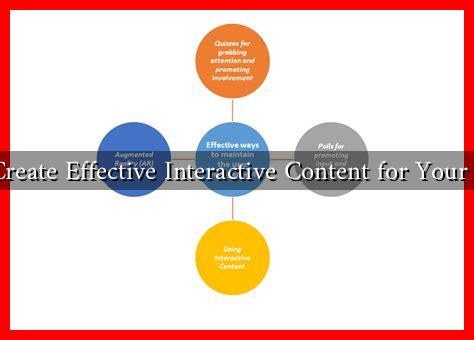-
Table of Contents
- How to Create Effective Interactive Content for Your Audience
- Understanding Interactive Content
- Benefits of Interactive Content
- Steps to Create Effective Interactive Content
- 1. Know Your Audience
- 2. Choose the Right Format
- 3. Focus on User Experience
- 4. Incorporate Storytelling
- 5. Promote and Share
- Case Study: The Success of Interactive Content
- Measuring Success
- Conclusion
How to Create Effective Interactive Content for Your Audience
In the digital age, capturing and retaining audience attention is more challenging than ever. Traditional content formats often fall short in engaging users, leading to a growing interest in interactive content. This article explores how to create effective interactive content that resonates with your audience, enhances user experience, and drives engagement.
Understanding Interactive Content
Interactive content refers to any content that requires active participation from the user. Unlike passive content, where users simply consume information, interactive content encourages users to engage, explore, and interact. Examples include quizzes, polls, interactive infographics, and calculators. According to a study by the Content Marketing Institute, interactive content generates twice the engagement of static content, making it a powerful tool for marketers.
Benefits of Interactive Content
Creating interactive content offers several advantages:
- Increased Engagement: Interactive content captures attention and keeps users engaged longer.
- Enhanced Learning: Users retain information better when they actively participate in the learning process.
- Data Collection: Interactive content can provide valuable insights into user preferences and behaviors.
- Improved Brand Loyalty: Engaging experiences foster a stronger connection between the audience and the brand.
Steps to Create Effective Interactive Content
To create interactive content that resonates with your audience, follow these essential steps:
1. Know Your Audience
Understanding your audience is crucial. Conduct surveys, analyze user behavior, and create personas to identify their preferences, interests, and pain points. Tailoring your content to meet their needs will enhance engagement.
2. Choose the Right Format
Select an interactive format that aligns with your goals and audience preferences. Some popular formats include:
- Quizzes: Fun and engaging, quizzes can educate users while providing personalized results.
- Polls and Surveys: These tools gather opinions and feedback, making users feel valued.
- Interactive Infographics: Visual storytelling can simplify complex information and encourage exploration.
- Calculators: Useful for providing personalized estimates or recommendations based on user input.
3. Focus on User Experience
User experience (UX) is paramount in interactive content. Ensure that your content is:
- Intuitive: Users should easily understand how to interact with the content.
- Visually Appealing: Use attractive design elements to draw users in.
- Mobile-Friendly: Optimize content for mobile devices, as a significant portion of users access content on smartphones.
4. Incorporate Storytelling
Storytelling can enhance the effectiveness of interactive content. Create a narrative that guides users through the experience, making it more relatable and memorable. For instance, BuzzFeed’s quizzes often incorporate storytelling elements that resonate with users, making them shareable and engaging.
5. Promote and Share
Once your interactive content is created, promote it through various channels. Utilize social media, email newsletters, and your website to reach a broader audience. Encourage sharing by incorporating social sharing buttons and creating compelling calls to action.
Case Study: The Success of Interactive Content
A notable example of effective interactive content is the “What Type of Dog Are You?” quiz by BuzzFeed. This quiz not only entertained users but also encouraged sharing, resulting in millions of engagements. The quiz’s success highlights how interactive content can drive traffic and enhance brand visibility.
Measuring Success
To determine the effectiveness of your interactive content, track key performance indicators (KPIs) such as:
- Engagement rates (time spent, interactions)
- Conversion rates (leads generated, sales)
- Social shares and comments
- User feedback and satisfaction
Utilizing analytics tools can help you gather insights and refine your strategy for future content.
Conclusion
Creating effective interactive content requires a deep understanding of your audience, careful selection of formats, and a focus on user experience. By incorporating storytelling and promoting your content effectively, you can enhance engagement and drive meaningful interactions. As the digital landscape continues to evolve, embracing interactive content will be essential for brands looking to stand out and connect with their audience. For more insights on interactive content strategies, visit Content Marketing Institute.

